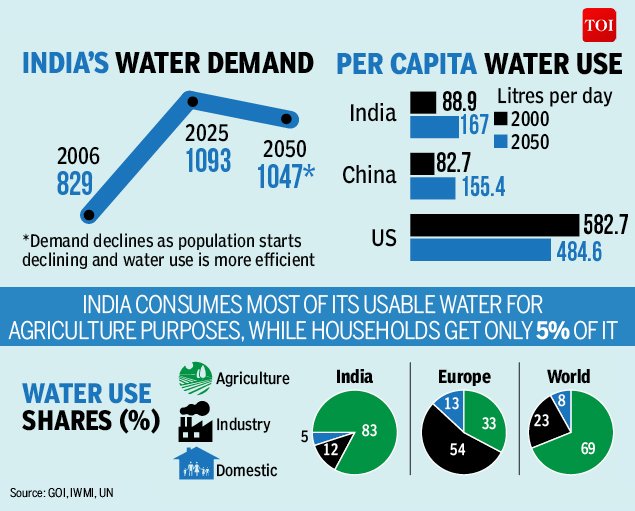
There is much truth behind the saying “out of sight, out of mind.”
India’s groundwater resources are depleting in both quality and quantity, as per data made available by the Central Ground Water Board. India is the world’s largest user of groundwater. The country’s economy is tagged to groundwater development in many ways and its inadequacy will endanger the progress.
Groundwater crisis is not the result of natural factors; it has been caused by human actions. During the past two decades, the water level in several parts of the country has been falling rapidly due to an increase in extraction. The quality of groundwater is getting severely affected because of the widespread pollution of surface water. Besides, discharge of untreated waste water through bores and leachate from unscientific disposal of solid wastes also contaminates groundwater, thereby reducing the quality of fresh water resources.
If the same continues then by 2025 2/3rd Of Humanity Will Face Water Shortage.
Solutions to Groundwater Depletion
We should reduce our use of chemicals and dispose of them properly.
We are not paying attention and are simply unaware of how vital it is to keep pollution from occurring beneath the ground. The water from businesses and private residences that run into the streets and sewage systems are generally loaded with chemicals. These chemicals find their way into larger bodies of water and absorb into the ground, poisoning animals and the soil. By using less chemicals and discarding of them carefully, we keep them from adding toxic materials into our water supply. So, as an environmental solution we need to concentrate in developing the concept of ETP/STP/FSTP, CETP which support in water recycling & restoring by removing harmful contaminants/pollutants from the water that is used by hotels, restaurants, resorts, hospitals, industries etc. and thereby converting dirty, polluted and unhealthy water into clean, safe and pure water so that it can meet quality standard and can be reused.
Raise the level of ground water through rain water harvesting.
Rainwater harvesting is the storing of rainwater during the monsoon season for the purpose of using it during periods of water scarcity by accumulated and stored the rain water with the intention of reusing it during the dry season or when there is a drought. Systematic rainwater harvesting can help in irrigation with minimum use of technology and is therefore cost effective. This simple method can help farmers to prevent their crops from drying due to lack of water. It also creates a sense of social responsibility and awareness about the environment.
Following actions are urgently needed to improve rainfall, to conserve more water and to educate the people around how to achieve the goal –
1. First of all, the green cover around the village has to be increased. Trees attract rains. More rains mean more water for ground water recharging.
2. Rejuvenate the ponds. Desiltation increases the depth which in turn results in increased water holding capacity. The ponds should have good number of pits or holes around and which will also hold water to keep water level high in the ponds
3. Make good number of small stop dams. The construction of small stop dams hardly requires any money except hard work of 2/3 days.
4. The rain water shouldn’t be allowed just to drain out in the river. Any arrangement to create a water channel which will have water running inside it for 3/4 kms. It will give ample opportunity for the earth to absorb more and more water. It will further increase the ground water.
5. The farmers are required to raise such crops which need less amount of water. This will require less water to be pulled out.
Organizing mass awareness programmes
Central Ground Water Authority (CGWA) has been constituted under “The Environment (Protection) Act, 1986” for the purpose of regulation and control of ground water development and management in the Country & CGWB has been organizing mass awareness programmes in the Country to promote rain water harvesting and artificial recharge to ground water.
Central Ground Water Board (CGWB) is implementing National Aquifer Mapping and Management program (NAQUIM), which envisages mapping of aquifers (water bearing formations), their characterization and development of Aquifer Management Plans to facilitate sustainable management of Ground Water Resources.
NAQUIM was initiated in 2012 as a part of the ‘Ground Water Management and Regulation’ scheme with the objectives to delineate and characterize the aquifers and develop plans for sustainable ground water management in the country. The State-wise information is shared with States/Union Territory for implementation.
We need to work together to sustainably manage this precious resource. At the same time, we need profound changes in the structure of incentives to support farmers in moving towards less water-intensive crops. We also need to break the groundwater-energy nexus that has only encouraged the mining of groundwater. This needs to be urgently implemented through the length and breadth of India.
